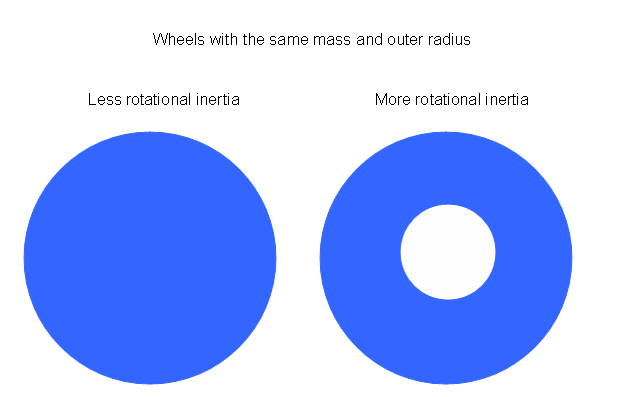Rotational Inertia & Tangential Velocity
Rotational Inertia is the willing an object has to turn. If something had a high rotational inertia, it's going to take more effort for it to rotate, and low rotational inertia will be a higher chance of rotating. To have a high rotational inertia, the mass of the object if spread out unevenly or far from the point of axis, like a hoola-hoop or volleyball. To have a small/low rotational inertia, mass has to be spread out evenly throughout the object and/or close to its centre axis, like a bowling ball and a meter stick with weights closer to the centre axis.
Rotational velocity is how fast the spot on a circular object is moving. Every spot on the object have equal rotational velocity because they travel the same circle in same amount of time. Tangential velocity is different from rotational velocity. The further out you go from the centre of the circle rotating, the faster you'll be going tangentially. This is because you are now traveling a greater distance in the same time, the middle little distance in same time.
This leads to the conservation of Angular Momentum:
Conservation of Angular Momentum
This conservation explains the certain angular acceleration of, lets say, an ice skater. When she brings her legs and arms in, she decreases her body's inertia.
rotational velocity x rotational inertia = rotational velocity x rotational inertia
Torque
Torque depends on two factors, lever arm and force. Torque is the willing an object is going to rotate. There is the objects clockwise and counter clockwise torques (for which way it will rotate). Ever hold a baseball bat on one finger and see it balances with more of the little side on one side compared to the big side. This is because of conservation of torque. The two sides don't weigh the same, they just have equal torques which make them balance. This is an example of the equation of conservation of torque:
force x leverarm=force x leverarm.
Centre of Gravity and Mass
Going back to the baseball bat, where your finger is, see how it's balancing there, that is where the centre of gravity of the bat is. The centre of gravity is where the force of gravity mostly affects an object. It is 99% of the time directly in the middle of the object. Centre of mass is the same thing of centre of gravity but can be changed. Let's say you are standing still, your centre of gravity is over your base of support which is your feet. Then you are given a large box to carry, you lean back, why? You are adding mass to a side of you so you balance out your centre of mass by keeping it over support. If it leaves support, you or the object will fall over. Objects tilting over and don't fall are objects who's centre of gravity is over support, just like the Leaning Tower of Pisa.
Centripetal and Centrifugal "Forces"
Why is forces in quotes. This is because these aren't really forces. They are a description or example of a object being affected. Centripetal is when an object is being pulled/rotated back into the rotational of an object, like a cup on a string. The string is the centripetal force pulling the cup into the centre. Centrifugal is the opposite. Just remember they're not forces, just occurrences.


No comments:
Post a Comment